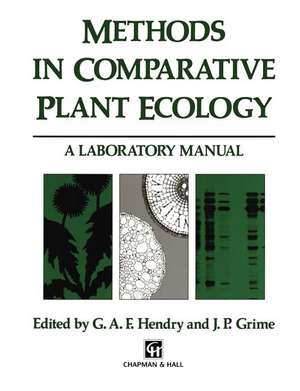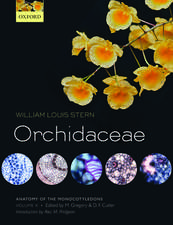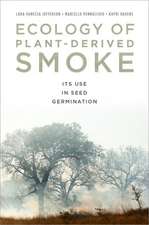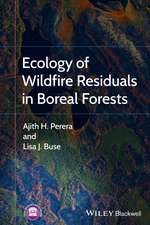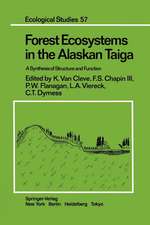Methods in Comparative Plant Ecology: A laboratory manual
Editat de G. A. Hendry, J.P. Grimeen Limba Engleză Hardback – 31 ian 1993
| Toate formatele și edițiile | Preț | Express |
|---|---|---|
| Paperback (1) | 1001.81 lei 6-8 săpt. | |
| SPRINGER NETHERLANDS – 30 oct 2012 | 1001.81 lei 6-8 săpt. | |
| Hardback (1) | 957.62 lei 6-8 săpt. | |
| SPRINGER NETHERLANDS – 31 ian 1993 | 957.62 lei 6-8 săpt. |
Preț: 957.62 lei
Preț vechi: 1167.83 lei
-18% Nou
Puncte Express: 1436
Preț estimativ în valută:
183.26€ • 198.100$ • 153.94£
183.26€ • 198.100$ • 153.94£
Carte tipărită la comandă
Livrare economică 23 aprilie-07 mai
Preluare comenzi: 021 569.72.76
Specificații
ISBN-13: 9780412462306
ISBN-10: 0412462303
Pagini: 252
Ilustrații: XVIII, 252 p.
Dimensiuni: 189 x 246 x 18 mm
Greutate: 0.79 kg
Ediția:1993
Editura: SPRINGER NETHERLANDS
Colecția Springer
Locul publicării:Dordrecht, Netherlands
ISBN-10: 0412462303
Pagini: 252
Ilustrații: XVIII, 252 p.
Dimensiuni: 189 x 246 x 18 mm
Greutate: 0.79 kg
Ediția:1993
Editura: SPRINGER NETHERLANDS
Colecția Springer
Locul publicării:Dordrecht, Netherlands
Public țintă
ResearchCuprins
1 Introduction.- 1.1 The need for comparative laboratory studies.- 1.2 How to use the manual.- 1.3 Abbreviations.- 2 General procedures and methodologies.- 2.1 Seed collecting, cleaning and long-term storage.- 2.2 Seed viability and germination.- 2.3 The ISP aerial environment: lighting, day length, temperature and humidity.- 2.4 ISP germination and rooting environments; sand, compost and solution culture.- 2.5 Harvesting, recording weight, area and length.- 2.6 Photographic recording.- 2.7 The ISP standard regime.- 3 Methods of comparative study.- Anatomy.- 3.1 Aerenchyma, intercellular gas space and aeration.- 3.2 Functional plant anatomy.- DNA.- 3.3 Chromosome number.- 3.4 Nuclear DNA amount.- Environmental impacts.- 3.5 Anoxia tolerance in germinating seeds, rhizomes, stolons and tubers.- 3.6 Response to defoliation.- 3.7 Desiccation tolerance.- 3.8 Drought tolerance.- 3.9 Effect of high temperatures on protein synthesis.- 3.10 Herbicide selectivity.- 3.11 Plant responses to low temperatures.- 3.12 Ozone sensitivity.- 3.13 Sulphur dioxide pollution.- 3.14 Sunfleck utilization.- 3.15 Ultra-violet (UV-B) radiation.- Growth.- 3.16 Adventitious rooting of cuttings.- 3.17 Carbon budget.- 3.18 Day length responses.- 3.19 Establishment in a vertical light gradient.- 3.20 Foraging for light.- 3.21 Foraging for mineral nutrients.- 3.22 Fresh weight/dry weight and related ratios.- 3.23 Constant temperature and shade.- 3.24 Fluctuating temperature and drought.- 3.25 Mean relative growth rate.- 3.26 Response to carbon dioxide enrichment.- 3.27 Variation in RGR underlying carbon economy.- Leaves.- 3.28 Decomposition.- 3.29 Defence chemistry.- 3.30 Longevity.- 3.31 Palatability.- 3.32 Tearability.- Metabolism.- 3.33 Calculation of specific activities of enzymes.- 3.34 Carbon isotope discrimination and water use efficiency.- 3.35 Nitrate reductase activity.- 3.36 Acid phosphatases.- 3.37 Photosynthesis and chlorophyll fluorescence: simultaneous measurements.- 3.38 Photosynthesis and respiration: use of O2electrodes.- 3.39 Respiration: the alternative pathway.- 3.40 Respiration: cytochrome c oxidase activity.- 3.41 Storage carbohydrates.- 3.42 Stress indicators: chlorophylls and carotenoids.- 3.43 Stress indicators: electrolyte leakage.- 3.44 Stress indicators: lipid peroxidation.- Mineral nutrients.- 3.45 Chemical analysis.- 3.46 Uptake and yield.- Roots.- 3.47 Architectural analyses.- 3.48 Mycorrhizal infection: assessment and quantification.- 3.49 Penetration and response to drought.- Seeds.- 3.50 Buoyancy in air.- 3.51 Defence chemistry (cyanide).- 3.52 Defence chemistry (phenols).- 3.53 Dormancy breaking.- 3.54 Germination at alternating temperatures.- 3.55 Germination at a range of constant temperatures.- 3.56 Germination and the high irradiance reaction.- 3.57 Germination and soil water potential.- 3.58 Mineral nutrient content.- 3.59 Morphology and colour.- 3.60 Organic reserves.- 3.61 Persistence in soil.- 3.62 Size.- Shoots.- 3.63 Architecture and vigour.- Toxicity.- 3.64 Aluminium.- 3.65 Cadmium sensitivity and constitutive resistance.- 3.66 Iron.- 3.67 Sulphide.- 3.68 Variability in seed storage proteins.- 4 Quantitative synthesis.- 5 Epilogue: the future development of comparative methodologies.- The problem.- The search for an answer.- Species index.
Recenzii
This book is ring bound which allows the volume to lie open on the laboratory bench. And make no mistake, it will lie open on many laboratory benches! Every plant ecology laboratory will want to have at least one copy. - Journal of Ecology
It will be of value not only to the experienced researcher but also to the novice starting a project...extremely useful - New Phytologists
There is much here of interest to teachers of A level and undergraduate biology and environmental science students. - The Biologist
The manual has been well written and edited...very useful to beginning graduate students who are looking for suitable techniques...You do not have to be an adherent of the comparative plant ecology school to find this book a useful addition to your bookshelf... - Ecology
It will be of value not only to the experienced researcher but also to the novice starting a project...extremely useful - New Phytologists
There is much here of interest to teachers of A level and undergraduate biology and environmental science students. - The Biologist
The manual has been well written and edited...very useful to beginning graduate students who are looking for suitable techniques...You do not have to be an adherent of the comparative plant ecology school to find this book a useful addition to your bookshelf... - Ecology
